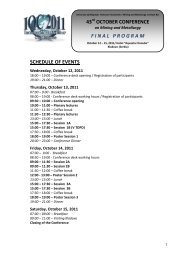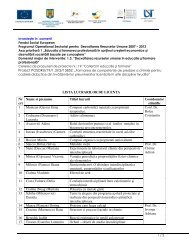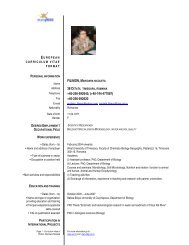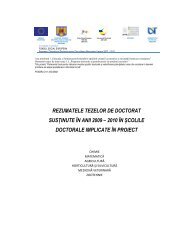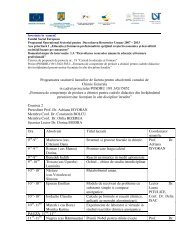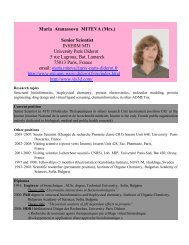Download PDF
Download PDF
Download PDF
Create successful ePaper yourself
Turn your PDF publications into a flip-book with our unique Google optimized e-Paper software.
Annals of West University of Timisoara<br />
Series of Chemistry 20 (1) (2011) 87-93<br />
NOVEL COMPLEXES OF COPPER (II) AND CADMIUM<br />
(II) WITH S-FUNCTIONALISED 1,2,4-TRIAZOLIC<br />
LIGAND: VIBRATIONAL STUDY<br />
I. V. Ledeţ i a , V. N. Bercean b , Andreea A. Alexa c<br />
a<br />
”Victor Babeş” University of Medicine and Pharmacy, Faculty of Pharmacy, No.2<br />
Eftimie Murgu Sq., RO-300041, Timişoara, ROMANIA<br />
b<br />
“Politehnica" University of Timişoara, Faculty of Industrial Chemistry and<br />
Environmental Engineering, Carol Telbisz 6, RO-300001 Timişoara, ROMANIA<br />
c<br />
”Victor Babeş” University of Medicine and Pharmacy, Faculty of Medicine, No.2<br />
Eftimie Murgu Sq., RO-300041, Timişoara, ROMANIA<br />
Received: 1 February 2011 Modified 27 February 2011 Accepted 31 March 2011<br />
SUMMARY<br />
Syntheses of novel metal complexes of Cd 2+ and Cu 2+ was carried out in aqueous<br />
solution, using CdI 2 and CuCl 2·2H 2O as source for metal ions and sodium salt of 4H-4-<br />
amino-5-carboxymethylsulfanyl-3-phenyl-1,2,4-triazole as ligand. All the compounds were<br />
preliminary characterized by melting point and IR spectroscopy.<br />
Keywords: metal complexes; S-alkylated 1,2,4-triazole; amino-mercapto-triazole<br />
INTRODUCTION<br />
1,2,4-triazole and its derivatives have gained great attention as ligands to transition<br />
metals by the fact that they unite the coordination geometry of both pyrazoles and<br />
imidazoles, and in addition exhibit a strong and typical property of acting as bridging<br />
ligands between two metal centers. In this bridging capacity, the 1,2,4-triazole ligands show<br />
a great coordination diversity, especially when the triazole nucleus is substituted with<br />
additional donor groups. This property together with their strong σ donor properties and the<br />
relative ease of synthesis make them very appealing for the design of new polynuclear metal<br />
87
L EDEŢ I I.V., B ERCEAN, V.N.<br />
complexes with interesting properties [1].<br />
Metal complexes derived from transition metals are known for their antibacterial,<br />
insecticidal and pesticidal activities [2]. 1,2,4-Triazole ligands are an important class of<br />
compounds, that are used in modern analytical chemistry for the dosage of heavy-metals<br />
from waste waters using spectrophotometric methods [3,4]. Also, the triazolic nucleus is<br />
widely used in well-known pharmaceuticals (like Fluconazole, Itraconazole, Voriconazole,<br />
Terconazole etc.)[5], and in the synthesis of new bio-active agents [6-11].<br />
MATERIALS AND METHODS<br />
The reagents were commercial products (Merck, Fluka, Aldrich) and used without<br />
further purification, except compound 1a was prepared by an original method, mentioned in<br />
our previous studies [12]. Melting points were determined on a Boethius PHMK (Veb<br />
Analytik Dresden) instrument, and thin-layer chromatography was carried out on silica gelcoated<br />
plates 60 F 254 Merck using benzene: methanol 7:3, benzene: methanol 3:7 or<br />
benzene: ethyl acetate 1:1 (v/v) as eluents. IR spectra were recorded in KBr pellet on a<br />
Jasco FT/IR-410 spectrophotometer.<br />
Synthesis of ligand (1b) (LNa): sodium salt of 4H-4-amino-5-<br />
carboxymethylsulfanyl-3-phenyl-1,2,4-triazole<br />
To a suspension of 4H-4-amino-5-carboxymethylsulfanyl-3-phenyl-1,2,4-triazole<br />
(1a) (10.00 g, 40 mmol) in distilled water (50 mL), a NaOH 1M solution is added (40.0<br />
mL). The suspension is heated and maintained at 40 o C for 2h, and then the clear, colourless<br />
formed solution is purified with active charcoal. After filtration, the solution was cooled at<br />
r.t. and the solvent was removed by distillation under reduced pressure (10 mm Hg). The<br />
white-crystalline product (1b) (chromatographically pure) was used for the synthesis of the<br />
metal complexes.<br />
The syntheses of metal complexes of Cd 2+ and Cu 2+ with sodium salt of 4H-4-<br />
amino-5-carboxymethylsulfanyl-3-phenyl-1,2,4-triazole (LNa)<br />
The ligand LNa (1b) (0.709g, 26 mmol) was dissolved, under stirring, in distilled<br />
water (6 mL), when a colourless solution was formed. Separately, transition metal salts (13<br />
mmol, corresponding to 0.476g CdI 2 and 0.221g CuCl 2·2H 2 O respectively) were dissolved<br />
in distilled water (2.5 mL). The aqueous solution of ligand (1b) was added dropwise under<br />
intense stirring to the metal salt solution, and a coloured suspension was obtained instantly.<br />
All the suspensions were maintained under stirring for approx. 2h, then filtered off under<br />
vacuum and washed with distilled water (20 mL). The products (2,3) were dried in an oven<br />
at 80 o C for 72h.<br />
88
NOVEL COMPLEXES OF COPPER (II) AND CADMIUM (II)<br />
RESULTS<br />
The synthesis of ligand (1b) used as starting material 4H-4-amino-5-<br />
carboxymethylsulfanyl-3-phenyl-1,2,4-triazole (1a), which by treatment in aqueous medium<br />
at 40 o C with stoichiometric amount of NaOH forms the corresponding soluble sodium salt<br />
(Figure 1). Sodium salt was purified, then isolated by removing water at reduced pressure.<br />
The purity of ligand (1b) was confirmed using thin layer chromatography, comparative to<br />
compound (1a), using three different elution systems: benzene: ethyl acetate 1:1, benzene:<br />
methanol 3:7 and benzene: methanol 7:3, respectively.<br />
Figure 1. The synthesis of sodium salt of 4H-4-amino-5-carboxymethylsulfanyl-3-phenyl-1,2,4-triazole<br />
The syntheses of Cd 2+ and Cu 2+ complexes were carried out in aqueous medium,<br />
accordingly to Figure 2:<br />
Figure 2. The syntheses of metal complexes derived from Cd 2+ and Cu 2+ with LNa<br />
Cd 2+ complex with LNa (2)<br />
Characterization of product: 0.44g of amorphous white powder;<br />
m.p. > 250 o C<br />
IR (KBr, cm -1 ): 3233, 1555, 1456, 1383, 1228, 769, 693, 592, 463.<br />
Cu 2+ complex with LNa (3)<br />
Characterization of product: 0.41g amorphous greenish-blue powder;<br />
m.p.= 188-189 o C (with decomposition, changing colour to brown)<br />
IR (KBr, cm -1 ): 3434, 1617, 1460, 1372, 1227, 1134, 1007, 776, 698, 598.<br />
The FT-IR spectra of metal complexes 2,3 (Figures 3,4) were recorded in the 4000<br />
– 400 cm -1 spectral range. Preliminary vibrational studies regarding IR spectroscopy of title<br />
compounds are discussed accordingly to literature data [13, 14].<br />
89
L EDEŢ I I.V., B ERCEAN, V.N.<br />
DISCUSSION<br />
The FT-IR spectra of metal complexes 2,3 (Figures 3, 4) were recorded in the 4000<br />
– 400 cm -1 spectral range. Preliminary vibrational studies regarding IR spectroscopy of title<br />
compounds are discussed accordingly to literature data [13].<br />
The 4000 – 2000 cm -1 spectral range is relevant for the characterization of the OH<br />
and CH groups. The presence of crystallization water in the metal complexes (2,3) generates<br />
complex, broad bands for (H 2 O) in the 2500-3500 cm -1 region of the IR spectra, for<br />
chelated compounds. On the other hand, the characteristic band for the carboxylic OH group<br />
(IR of 1a: 3620 cm -1 ) disappears in the IR spectra of 2,3, sustaining the formation of a<br />
coordination compound with carboxylate anion.<br />
Figure 3. IR spectrum for Cd 2+ complex<br />
The 2000 – 1000 cm -1 spectral range is relevant for both heterocyclic and alkylcarboxylic<br />
units of the ligand. The most important bands characteristic for the heterocyclic<br />
fragment fall in the 1560 – 1400 and 1200 – 1075 cm -1 spectral ranges, and are assigned to<br />
the (C=N) and (N-N) vibrating modes, respectively. As it concerns the alkyl-carboxylic<br />
substituent, the title spectral range offers information about both CH 2 and COOH groups:<br />
the presence of the CH 2 unit is sustained by the assignment of the (CH 2 ) at 1474 – 1430<br />
cm -1 in both spectra.<br />
90
NOVEL COMPLEXES OF COPPER (II) AND CADMIUM (II)<br />
Figure 4. IR spectrum for Cu 2+ complex<br />
The most interesting behaviour is revealed by the COOH/COO - group: according<br />
to literature [13, 14], the COOH group is characterized by two major vibrational modes:<br />
(C=O) and (C-OH), the latter being represented by two bands. With the deprotonation of<br />
COOH group in alkaline medium, the COO - group is expected to adopt a C 2v symmetry and<br />
to reveal in IR spectra both as (COO) and s (COO) vibrations. For the synthesized<br />
complexes, the band corresponding to (C=O) vibrational mode falls at 1555 cm -1 for Cd 2+<br />
complex and at 1617 cm -1 for Cu 2+ complex respectively, comparative to the one for<br />
protonated form of ligand (1a), where (C=O) appears at 1714 cm -1 .<br />
In conclusion, we may suggest the deprotonation of the carboxylic group in both<br />
metal derivatives and the coordination of the resulting carboxylato unit to the metal centers.<br />
However, the coordination behaviour of the ligand can be elucidated only by more spectral<br />
and structural investigations.<br />
The 1000 – 400 cm -1 spectral range is associated with group bending and other<br />
skeleton vibrational modes and it’s not relevant for the structure of metal complexes [13].<br />
CONCLUSION<br />
One ligand, namely the sodium salt (1b) of 4H-4-amino-5-carboxymethylsulfanyl-<br />
3-phenyl-1,2,4-triazole and two new metal complexes (2,3) were synthesized and<br />
preliminary-characterized by vibrational spectroscopy.<br />
91
L EDEŢ I I.V., B ERCEAN, V.N.<br />
By the analysis of IR spectra of title compounds (2,3), it is suggested the presence<br />
of crystallization water in the structure of the metal derivatives. On the other hand, the<br />
characteristic band for the carboxylic OH group (IR of 1a: 3620 cm -1 ) disappears in the IR<br />
spectra of 2,3, sustaining the formation of a coordination compound with carboxylate anion.<br />
Also, the deprotonation of the carboxylic group in all metal derivatives is sustained by the<br />
(C=O) vibrational mode, that falls at lower values in complexes, comparative to protonated<br />
ligand (1a).<br />
REFERENCES<br />
1. Haasnoot J.G., “Mononuclear, oligonuclear and polynuclear metal coordination compounds with<br />
1,2,4-triazole derivatives as ligands”, Coordination Chemistry Reviews 200-202 (2000) 131-185.<br />
2. Kulkarni A. D., Patil S.A., Naik V. H., Badami S.P. “DNA cleavage and antimicrobial investigation<br />
of Co(II), Ni(II), and Cu(II) complexes with triazole Schiff bases: synthesis and spectral<br />
characterization”, Med. Chem. Res., 20(3) (2009) 346-354.<br />
3. Osman, M.M., Makhyoun, M. A., Tadros, A. B., “Spectral and magnetic studies on the complexes<br />
of 2,5-dimercapto-1,3,4-thiadiazole and 5-mercapto-3-phenyl-1,3,4-thadiazoline-2thione with<br />
cobalt(II), nickel(II), copper(II), zinc(II), and cadmium(II).” Bull. Soc. Chim. Fr., 11-12 (1980) 451-<br />
454.<br />
4. Henke K., Atwood D. A., “Group 2 Complexes of 2,4,6-Trimercaptotriazine (TMT)”, Inorg. Chem.,<br />
37(2) (1998) 224-227.<br />
5. Sweetman S., (editor) “The complete drug reference” 34 th edition, Pharmaceutical Press,<br />
London, 2004, p.102<br />
6. Shaker R. M., “The chemistry of mercapto- and thione- substituted 1,2,4-triazoles and their utility<br />
in heterocyclic synthesis”, Arkivoc (IX) (2006) 59-112.<br />
7. Eweiss, N.F., Bahjaj, A.A., Esherbini, E.A., “Synthesis of heterocycles. Part VI. Synthesis and<br />
antimicrobial activity of some 4-amino-5-aryl-1,2,4-triazole-3-thiones and their derivatives”, J.<br />
Het. Chem., 23(145) (1986) 1451-1458<br />
8. Sung, K., Lee, A.-R., “Synthesis of ((4,5-Disubstituted-4H-1,2,4-triazol-3-yl)thio)alkanoic acids<br />
and their analogues as possible antiinflammatory agents”, J. Het. Chem. 29 (1992) 1101-1109.<br />
9. Sisu I., Bercean V. N., Badea V., Caproiu M.T., Sisu E., ”Sinteza S-thioribofuranosidei utilizând<br />
mercaptotriazolul”, Rev. Chim. Bucharest, 60(9) (2009) 880-882.<br />
10. Marakos P., Garoufalias S., Tani E., Kourounakis P.N., Athanasiou G., Lada A., “Synthesis and<br />
antifungal and antioxidant properties of some new 5-substituted-4-amino(or aryl)-3-mercapto-<br />
4(H)-1,2,4-triazoles”, Arzneimittel-Forsch., 52(7) (2002) 572-577.<br />
11. Wu J. et al., “Synthesis of Novel Derivatives of 4-Amino-3-(2-Furyl)-5-Mercapto-1,2,4-Triazole as<br />
Potential HIV-1 NNRTIs”, Molecules, 12 (2007) 2003-2016.<br />
12. Ledeţi I.V., Bercean V.N., Badea V., Bălan M., Csunderlik C. “The alkylation of 1H-5mercapto-3-<br />
phenyl-1,2,4-triazole and 4H-4-amino-5-mercapto-3-phenyl-1,2,4-triazole”, Rev. Chim.<br />
Bucharest, 61(9) (2010) 833-837.<br />
13. Venter M.M., Chis V., Cinta Pinzaru S., Bercean V.N., Ilici M., Haiduc I., “Synthesis and<br />
vibrational studies on new complexes of monodeprotonated (4H-5-mercapto-1,3,4-thiadiazol-2-<br />
yl) thioacetic acid”, Studia Univ. Babes-Bolyai, Chemia, 52(1) (2007) 55-60.<br />
14. K. Nakamoto, “Infrared Spectra and Raman Spectra of Inorganic and Coordination Compounds”,<br />
John Wiley & Sons, New York, 1986, p. 96.<br />
92




